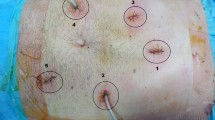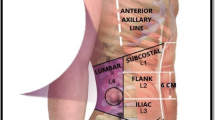Abstract
Purpose
The aim of this article is to describe the technique and early follow-up results of abdominal wall reconstruction (AWR) by minimally invasive surgery (MIS); it concerns the already described endoscopic (retromuscular) Rives procedure (e-Rives) and posterior component separation with transversus abdominis release (TAR) by endoscopic approach (eTEP-TAR).
Method
This is a prospective study which consists of 60 patients operated on between May 2016 and December 2017 by a single surgeon and monitored until July 2018. This is a heterogenic cohort with different hernia types (lateral, median, combined) which were also treated with different meshes. This material includes physiological and biomechanical issues related to the abdominal wall, the key stages of the operation including port placement strategy.
Results
The group of patients are 55% male, having a mean age of 53.3 years old, mean BMI of 29.3 and median ASA score of 1.83. The majority of the hernia types is represented by incisional hernia (61.7%) located especially on the median side of the abdomen (80%); more than half of them (60%) are reducible. There were 6 (10%) intraoperative complications that lead to four conversions to open or traditional laparoscopic techniques. Postoperative re-admission—two cases: one case with small bowel obstruction, solved by laparoscopic surgery and one case with hemorrhagic gastritis because of non-steroidal anti-inflammatory treatment that required only medical treatment. Quality of life (assessed on a 0–10 scale) evaluating the postoperative pain, normal activity and aesthetics, shows a significant improvement after 2 weeks and 3 months postoperatively compared to the preoperative level. 93.3% of the patients have been monitored and no recurrences after a mean of 15 months have been reported.
Conclusion
A thorough understanding of the anatomy and surgical technique is mandatory. The eTEP approach is a feasible and safe option in MIS ventral hernia repair.









(Courtesy of Dr. Igor Belyansky)


(Courtesy of Dr. Igor Belyansky)

(Courtesy of Dr. Igor Belyansky)



Similar content being viewed by others
References
Cox TC, Pearl JP, Ritter EM (2010) Rives–Stoppa incisional hernia repair combined with laparoscopic separation of abdominal wall components: a novel approach to complex abdominal wall closure. Hernia 14(6):561–567
Forte A et al (2011) Rives technique is the gold standard for incisional hernioplasty. An institutional experience. Ann Ital Chir 82(4):313–317
LeBlanc KA, Booth WV (1993) Laparoscopic repair of incisional abdominal hernias using expanded polytetrafluoroethylene: preliminary findings. Surg Laparosc Endosc 3(1):39–41
Bittner R et al (2014) Guidelines for laparoscopic treatment of ventral and incisional abdominal wall hernias (International Endohernia Society (IEHS)-part 1. Surg Endosc 28(1):2–29
Miserez M, Penninckx F (2002) Endoscopic totally preperitoneal ventral hernia repair. Surg Endosc 16(8):1207–1213
Schwarz J, Reinpold W, Bittner R (2017) Endoscopic mini/less open sublay technique (EMILOS)—a new technique for ventral hernia repair. Langenbeck’s Arch Surg 402(1):173–180
Belyansky I, Zahiri HR, Park A (2016) Laparoscopic transversus abdominis release, a novel minimally invasive approach to complex abdominal wall reconstruction. Surg Innov 23(2):134–141
Belyansky I et al (2018) A novel approach using the enhanced-view totally extraperitoneal (eTEP) technique for laparoscopic retromuscular hernia repair. Surg Endosc 32(3):1525–1532
Daes J (2012) The enhanced view-totally extraperitoneal technique for repair of inguinal hernia. Surg Endosc 26(4):1187–1189
Novitsky YW (2016) Posterior component separation via transversus abdominis muscle release: the TAR procedure. In: Novitsky YW (ed) Hernia surgery. Springer International Publishing, Cham, pp 117–135
Ramirez OM, Ruas E, Dellon AL (1990) ‘Components separation’ method for closure of abdominal-wall defects: an anatomic and clinical study. Plast Reconstr Surg 86(3):519–526
Rosen MJ (2015) Atlas of Abdominal Wall Reconstruction - ISBN: 9781437727517| US Elsevier Health Bookshop. Chap 11. pp 185–201 [Online]. http://www.us.elsevierhealth.com/product.jsp?isbn=9781437727517&navAction=&navCount=0. Accessed 8 Oct 2015
De Keulenaer BL, De Waele JJ, Powell B, Malbrain MLNG (2009) What is normal intra-abdominal pressure and how is it affected by positioning, body mass and positive end-expiratory pressure? Intensive Care Med 35(6):969–976
Losken A, Jeffrey J (2012) Advances in abdominal wall reconstruction. Thieme Publishers, New York
Muysoms FE et al (2009) Classification of primary and incisional abdominal wall hernias. Hernia 13(4):407–414
Rath AM, Attali P, Dumas JL, Goldlust D, Zhang J, Chevrel JP (1996) The abdominal linea alba: an anatomo-radiologic and biomechanical study. Surg Radiol Anat 18(4):281–288
Nahabedian MY (2016) Diagnosis and management of diastasis recti. In: Novitsky YW (ed) Hernia surgery. Springer International Publishing, Cham, pp 323–336
Criss CN, Petro CC, Krpata DM, Seafler CM, Lai N, Fiutem J (2014) Functional abdominal wall reconstruction improves core physiology and quality-of-life. Surgery 156(1):176–182
Kukleta JF, Freytag C, Weber M (2012) Efficiency and safety of mesh fixation in laparoscopic inguinal hernia repair using n-butyl cyanoacrylate: long-term biocompatibility in over 1,300 mesh fixations. Hernia 16(2):153–162
Author information
Authors and Affiliations
Corresponding author
Ethics declarations
Conflict of interest
The author(s) declare that they have no competing interests.
Ethical approval
The protocol was approved by the ethics committee of the institutions.
Human and animal rights
This article does not contain any studies with human participants or animals performed by any of the authors.
Informed consent
All the patients gave the informed consent for procedure and scientific data use as standard in our hospital.
Additional information
Publisher’s Note
Springer Nature remains neutral with regard to jurisdictional claims in published maps and institutional affiliations.
Rights and permissions
About this article
Cite this article
Radu, V.G., Lica, M. The endoscopic retromuscular repair of ventral hernia: the eTEP technique and early results. Hernia 23, 945–955 (2019). https://doi.org/10.1007/s10029-019-01931-x
Received:
Accepted:
Published:
Issue Date:
DOI: https://doi.org/10.1007/s10029-019-01931-x




